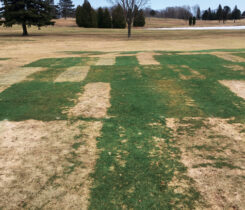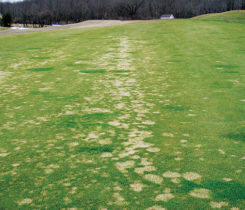The view from the Treetops Resort
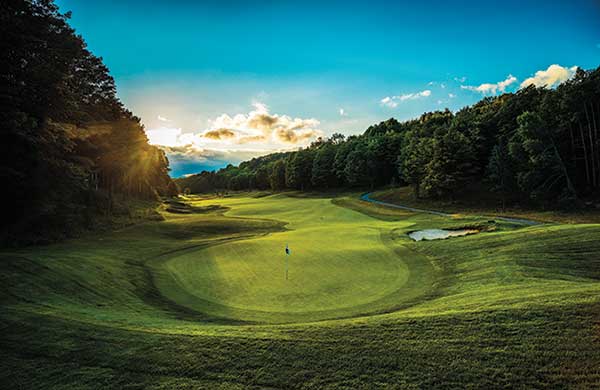
This photo was taken behind No. 10 on the Premier course. This is the only course designed by Tom Fazio in the state of Michigan and is Treetops’ most-played course. (Photo: Treetops Resort)
Nestled in the heart of northern Michigan, Gaylord’s Treetops Resort features 63 holes of golf known as “The Five Wonders of Michigan,” including The Masterpiece, The Premier, The Signature, The Tradition and Threetop (a 9-hole executive course that hosted a par-3 shootout from 1999 to 2006 with contestants like Nicklaus, Palmer and Trevino).
When Doug Hoeh, director of outside operations, first joined Treetops Resort in 2004, each course had a superintendent along with a full-time staff. But that changed during the Great Recession, as many staff members were laid off in 2009 and 2010.
“Little did we know, but this would lead remaining staff members to become more efficient and productive,” Hoeh says. “For example, we now utilize most of the staff to prep a course that has an outing/shotgun on it and then move them from that course to another that is less busy.”
Staff members — typically 35 to 40 throughout the season — always stay busy maintaining the course’s more than 1,500 acres of land, yet they rarely, if ever, conduct course maintenance during busy times. This allows guests to have the most enjoyable experience possible.
“Most days, we’re packed from the first tee time, but there’s always one course that has leagues and so forth on it, which allows us to move our staff in the middle of the day to that course,” Hoeh adds.
Fully utilizing employees by moving them to the course where their services are most required has allowed Treetops to reduce its full-time staff by nearly 35 percent. In addition to moving employees around during slower times of the day, Hoeh has a small crew that mows every evening, which gives his team a head start for the following day.
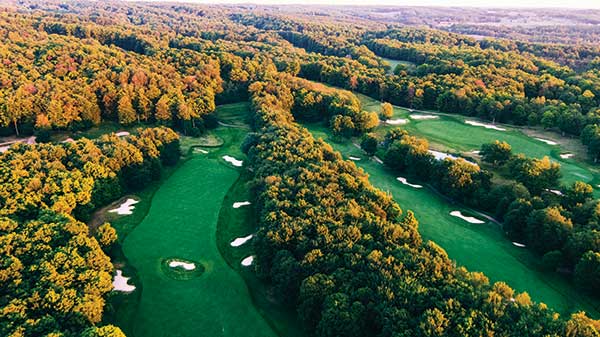
An aerial view of the Signature Course. No. 3 is located back right, No. 5 is located in the middle and No. 6 is located on the left side. Rick Smith designed the course after a trip overseas to Scotland and Ireland. It has 135 bunkers. (Photo: Treetops Resort)
“I always try to provide our staff full-time hours. We operate a ski hill during the winter, so we’re able to offer year-round employment,” he explains. “Summer is our busy season, so most employees average 45 hours per week then. Some may even average 50 hours during the golf season.”
“During the spring and fall, we try to provide employees 40-hour work weeks,” he explains, “but weather is a big factor in that. And, throughout the winter, there’s definitely enough positions available for staff to work 40 hours a week.”
Season-long maintenance
Every golf season, Treetops encounters two primary diseases: snow mold and dollar spot. To control snow mold, Hoeh and his crew usually apply Interface Stressgard at a rate of 4 fl. oz. per 1,000 sq. ft. in late October or early November, prior to the first snow accumulation of the off-season. If the weather allows, they’ll apply the fungicide at the same rate one more time during a midwinter thaw.
At the same time, they’ll also apply Mirage Stressgard at a rate of 1 fl. oz. per 1,000 sq. ft. If from the Treetops they’re able to apply the fungicide again during a thaw, they’ll wait at least 28 days before applying it for a second time.
To control dollar spot, Hoeh’s team uses a rotation of products based on price and always uses the lowest rates possible. If they decide to use a combination of Interface Stressgard and Mirage Stressgard, they’ll apply Interface Stressgard at a rate of 3 fl. oz. per 1,000 sq. ft. for 14 to 28 days on greens and tees, beginning in either March or April (depending on the weather).
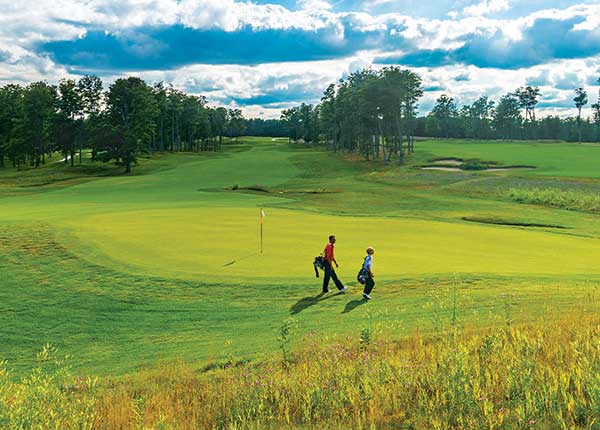
This photograph was taken from behind Hole No. 10 of The Tradition. The course was built to be a walking course, but Treetops does allow carts. A throwback to a more traditional-style course that plays “linksy,” The Tradition uses wooden flagsticks with pennant flags, along with wooden rakes and nontraditional tee markers and tee signs. (Photo: Treetops Resort)
Furthermore, they’ll apply Interface Stressgard at a rate of 2 fl. oz. per 1,000 sq. ft. for 14 to 28 days on fairways and other turf areas. And, at the same time, they’ll apply Mirage Stressgard at a rate of 1 fl. oz. per 1,000 sq. ft.
“Our concern is dollar spot resistance, which has developed with old demethylation inhibitors (DMIs),” Hoeh says. “We’re leery of using the same products more than once per season. I know there are many schools of thought on this subject of rotation, but this method has been working at Treetops.”
Aside from fungicides, Hoeh’s crew also applies various wetting agents, which he considers one of the most important products for snow mold control (a close second to fungicides).
Hoeh believes that as long as his staff can control soil moisture at levels that ensure turfgrass thrives with proper fertilization, the turf can fend for itself against snow mold, dollar spot and other environmental stresses.
Just as significant as fungicides and wetting agents are to consistent maintenance of pristine conditions on more than 1,500 acres of turf, full engagement with each of his 35 to 40 staff members is equally important.
“The key, to me, is making sure everyone is completely engaged and listening to each other,” Hoeh says. “I’m not the best greens mower on the crew, so if someone tells me they’d like to try mowing a certain way, I’m all for it.”
He adds, “This goes for any job. I’m open to suggestions and willing to try anything if it helps us accomplish our tasks more easily and effectively.”
A shocking rise in rounds
In addition to Treetops Resort’s 63 holes, Hoeh’s crew also oversees its 350-acre main property, which includes a lodge, an inn, a spa, a golf academy, a convention center and six bars and restaurants.
After the Great Recession, Hoeh adapted the ways in which his team maintained the property’s aesthetics, particularly its flower beds and hanging flower baskets.
“The main resort used to be peppered with annual flower beds and hanging flower baskets,” he says. “But, in the past 10 years, we’ve dramatically reduced the number of flowers on the property, as we only plant perennial grasses and flowers now.”
Additionally, Hoeh has focused more on high-traffic areas, especially hotel and restaurant entrances, to ensure the grasses, plants and flowers surrounding them always are lush and healthy.
To maintain the beauty of each of these entrances, Hoeh currently has 10 to 15 full-time staff members who focus only on the main property. Much like the team that oversees the resort’s 63 holes, Hoeh’s main resort crew works 45 to 50 hours per week during the summer and roughly 40 hours a week the rest of the year.
“We ultimately want to add more staff members to oversee the main property,” he adds. “This need for more assistance will likely only continue to increase in the coming months and years, mainly due to Treetops’ marketing initiatives.”
These initiatives — primarily brand marketing via an updated website, nationwide magazine advertisements, local and statewide television interviews, trade show plugs and consistent deals and promotions all season — increased the resort’s annual total rounds substantially a few years ago, from 40,000 in 2010 to 95,000 in 2011.
“Everyone was shocked by this sudden rise in rounds of golf, all within a year,” Hoeh states. “We had tees that didn’t have turf, rough that was beat so bad from cart traffic and bunker edges that were crumbling. We had to regroup and refocus our efforts.”
Less is more
Luckily, the sharp upturn in rounds led to a dramatic increase in Hoeh’s budget, as he was able to focus on turf health throughout the course, from the rough and fairways to the greens, bunker edges and tees. He began to conduct soil tests to see baselines then used the data to identify areas that needed fungicides the most.
“Green doesn’t mean healthy! We need vigorous-growing turf to withstand the daily beating it receives,” he says. “Since then, we’ve been able to target certain areas that need more attention than others, mainly through aerification, fertilization and topdressing.”
Hoeh and his crew have scheduled maintenance days every three weeks. During each maintenance day, the team focuses on only one course at a time, closing it until 3 p.m. Staff members perform most of their cultural practices during this time, including fertilizing, fly-mowing, spiking, spraying, trimming and topdressing.
“As more and more customers continue to visit the mecca of golf that’s northern Michigan, these maintenance days are the only way we’re able to maintain our courses’ exceptional conditions,” he says.
In 2020, Treetops Resort likely will welcome 70,000 to 80,000 golfers. Prior to the COVID-19 pandemic, the resort had anticipated upward of 100,000 golfers in the five-month-long golf season — figures it projects will be fully realized in 2021. As Hoeh prepares to welcome these guests, he will continue to focus on his greatest asset: the Great Lakes state’s extraordinary natural land features.
“We take great pride in what we do and the product we produce,” he says. “We also have a great staff that cares about the courses and how they look and play.” “And, we’re stewards of the land,” he notes, “as we always give the turf what it needs, but we never overdo. The fewer inputs we use, the better. Less is more, period.”









